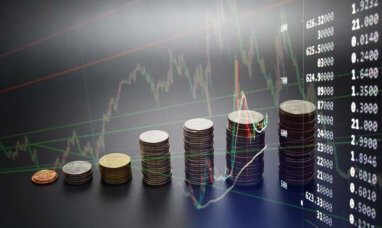Are you interested in learning about the stock market and how you can get started? Knowing some basic definitions and terms is a great way to prepare you for making your first trade.
Stock Market Definitions
Here are 25 common stock exchange terms for beginners:
1. Quote: Delayed vs. Real-time
A stock quote refers to the selling price of a stock at a particular time of day, usually during trading. The two types of stock quotes are delayed quotes and real-time quotes.
Delayed quotes are not served in real-time but lag approximately 15-20 minutes behind the current market data.
2. Ticker
A ticker is a stock symbol of a listed company on a stock exchange. For example, Apple is publicly traded on the NASDAQ as “NASDAQ:AAPL.” So, “AAPL” is its ticker symbol on that exchange.
You can add tickers to a watchlist on many websites, and it will show you the delayed or real-time quote of that stock.
3. Bid
A bid is what one is willing to pay for a stock. A bid price is set by the buyer and met by the sellers.
4. Ask
The ask price is what sellers want to sell their stock for.
5. Bid-Ask Spread
The bid-ask spread is the difference between how much buyers are willing to bid and what sellers are asking. You can imagine a stock having three prices: the quoted share price, the ask, and the bid.
For example, if ABC stock is traded at $8 per share and has an ask price of $10, the spread is $2. If the buyer chooses to buy for $10, they are paying the bid-ask spread.
The bid-ask spread is the main cost for trading securities aside from commission. If the buyer believes the stock could go up to $20, they can later sell at a profit of $10. That will make up the bid-ask spread.
Bid-ask can be thought of as the buyer’s ideal price and the seller’s ideal price. A buyer will want to pay less, while a seller wants to receive more for the stock. It’s also a way to measure supply and demand. If a stock is highly liquid, meaning it’s buying and selling fast, the spread will be small. Stocks that are harder to move have higher bid-ask spreads.
6. Buy
Buying stocks/securities can also be called “taking a position” in said company or index.
7. Sell
Sometimes you sell when you’ve made a profit after growth. Or, you might want to sell to cut your losses during a downturn in a specific stock or the market.
8. Trading Volume
The trading volume is the number of shares traded during a specified period of time. Daily trading volume is often used as a reference point to analyze trends.
9. Liquidity
Liquidity is how easy it is to convert an asset or stock into cash without affecting the market price. How easy it is to sell a security is an indicator of its liquidity. In general, the more volume a stock has traded, the more liquid it is.
If a consistent volume is being traded at stable, transparent prices, the stock market is highly liquid and healthy. When the spread between the price to buy and to sell securities is wide, this is an illiquid market as people aren’t buying. This can cause stock prices to fall and investors to have difficulty selling off depreciating stocks.
10. Market Orders
Retail traders beware! (That means you.) Don’t use market orders! Why? Say you want to sell a stock that’s trading at $1 per share at the moment. You bought at 90 cents and placed a market sell order when it hit $1.
That’s a 10% profit increase, right? Not bad. But wait! Just because you place an order doesn’t mean it’s fulfilled yet. Most major securities are pretty liquid, but the losses one can incur from a mismanaged market order can be staggering. For example, the stock could fall to 80 cents, and the investor would incur a 10 cent per share loss. Be warned: the investor has no actual control over the order price once the market order is filled.
11. Day Order
A day order is an order that sets to fulfill before close that trading day. It’s only good for the day, so if you don’t meet a buyer for your sale, you won’t sell.
12. Limit Order
Beginner stock traders must know to always use a limit order. This is an instruction to execute the order at a certain price.
For example, if the quote price of a stock is $1 and you set a limit order of $2, the order will not go through if the stock rises above $2 before the bid expires. Limit orders help traders hedge against risk.
13. Good-Till-Canceled
Limit orders always have a time by which they must be fulfilled. However, traders can also use a good-till-canceled (GTC) order. This kind of order will fulfill at a pre-set price multiple days or weeks from the order date.
This strategy is great for when a stock price might rise within a certain time frame. For example, if a trader owns a stock at $5 and believes it might get to $25 next month, they can set a good-till-cancelled order to sell the stock at a set price of $25. If the stock rises to $25 as they predict, the order will process.
GTC orders are used by investors who do not constantly watch price fluctuations. The NASDAQ and NYSE do not accept GTC orders. However, individual brokerages will still fulfill these orders internally.
14. PE Ratio
The PE Ratio is simply the price of a company’s shares divided by its earnings. Companies with a negative PE Ratio are not earning and usually do not list their PE ratio. This is not necessarily a bad thing. It may be that the company is new and has not yet started selling its product. If it starts selling soon, it can be profitable. But be wary as the lack of a PE Ratio could also indicate that a company is simply not profitable.
15. Dividend
Large, stable, and established companies that offer useful, high-quality products often issue dividends to shareholders as a reward for their stake in the company. Dividends are issued monthly, quarterly, or annually and are a percentage of each share. So if a stock trades at $100, a 2% dividend yield means shareholders will earn $2 every year for each share they hold.
When considering investing for regular dividend payments, an investor should look at a company’s dividend yield, history, and payout ratio. The Pepsi stock dividend is a great example. It has a 2.75% dividend yield and pays an annual of $4.30 per share. PepsiCo (NASDAQ:PEP) has grown its dividend for the last 49 consecutive years. The company pays 77.90% of its earnings as dividends.
Some companies choose not to issue cash dividends, instead choosing to pay dividends in the form of additional stock. Dividend investing is intimately associated with long-term growth investing.
16. Growth Investing
Growth investing is the skill of investing in high-value companies or assets that have a slower but more gradual and stable return. One of the most famous growth investors is Warren Buffet, with over $95 billion in assets under management in his firm Berkshire Hathaway. One of the best books on growth investing is The Intelligent Investor by Benjamin Graham, who was a mentor to Buffet.
17. Averaging Down
Investors average down when they buy more and more of a stock as the price goes down. This way, the average price they pay for the stock decreases. Doing this allows the investor to lower the average cost paid for the overall position on the stock while expecting that the share price will eventually rise. Finding a stock average down calculator online is a great way to see if this is a viable investment strategy.
18. IPO
An initial public offering (IPO) is when a private company lists to a stock exchange and issues share to the public to raise capital.
19. Day Trading
Day trading, also called high-frequency trading, involves tradings stocks or securities within minutes, and sometimes even seconds, of buying them. This kind of trading is done almost exclusively by skilled professional traders and investment firms utilizing high-frequency trading algorithms that automate the trading process.
Day trading relies heavily on timing the market instead of spending time in the market. It’s not recommended for beginners and is incredibly risky.
If you are an individual just starting out in the stock market, you’re a retail investor, not a day trader.
20. Market Cap
The market cap valuation is the total value of all outstanding shares, or all the shares already held by shareholders, of a publicly-traded company.
What is free float market cap? This is a method of calculating the market cap by multiplying the price of shares by the number of shares readily available.
21. Bull/Bear Market
A bull or bear market is closely associated with rallies and involves a downturn or an upswing.
A bull market is when prices are rising and many investors are buying. This usually indicates higher confidence in a company, sector, or the economy as a whole.
The bull’s opposite in the stock market is a bear market. Bear markets occur when there is a trend toward selling and the prices of stocks are falling. This can be caused by a number of factors. Many bigger bear markets involved recessions, such as the Great Depression and the 2008 Financial Crisis.
22. Volatility
A stock is volatile if its price moves up and down quickly and by significant increments.
23. Moving Average
What is the “moving average” of a stock? A moving average is a stock’s average price during a given period of time. There are various time frames, but 50 days, 100 days, 200 days, and so on are generally used to measure moving averages of stock prices.
24. Beta
Beta is an indicator of the difference between the price of a stock and the movement of the whole market. A beta of 2 means that for every 1 point the market moves, the stock moves 2 points.
25. ETF
Exchange-traded funds are grouped securities that allow investors to buy into a sector. Think of an ETF as a basket of stocks that are tracked. Prices are traded at a premium or loss compared to the net asset value of all the companies in the fund. Unlike common or preferred shares, ETFs do not imply ownership of the stocks.
Featured Image: Megapixl






